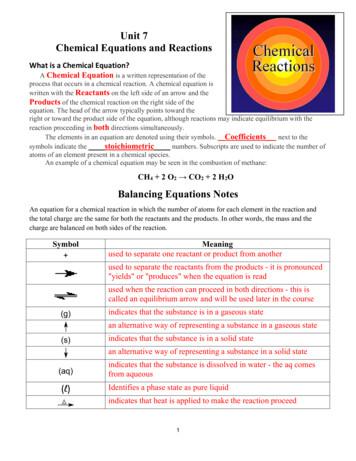3. CHEMICAL AND PHYSICAL INFORMATION 3.1 CHEMICAL IDENTITY
FUEL OILS1053. CHEMICAL AND PHYSICAL INFORMATION3.1 CHEMICAL IDENTITYInformation regarding the chemical identity of fuel oils is located in Table 3-l. Information on thecomposition of selected fuel oils, specifically fuel oil no. 2 and kerosene, is presented in Table 3-2.All of the fuel oil classes discussed in this Profile are refined from crude petroleum and may becategorized as either a distillate fuel or a residual fuel depending on the method of production. Fueloils no. 1 and no. 2 are distillate fuels which consist of distilled process streams. Residual fuel oilssuch as fuel oil no. 4 are residues remaining after distillation or cracking, or blends of such residueswith distillates (IARC 1989). Diesel fuels are approximately similar to fuel oils used for heating (fueloils no. 1, no. 2, and no. 4). All fuel oils consist of complex mixtures of aliphatic and aromatichydrocarbons. The aliphatic alkanes (paraffins) and cycloalkanes (naphthenes) are hydrogen saturatedand compose approximately 80-90% of the fuel oils. Aromatics (e.g., benzene) and olefins (e.g.,styrene and indene) compose 10-20% and l%, respectively, of the fuel oils. Fuel oil no. 1 (straightrunkerosene) is a light distillate which consists primarily of hydrocarbons in the C9—C16 range; fuel oilno. 2 is a heavier, usually blended, distillate with hydrocarbons in the C11-C20 range. Straight-rundistillates may also be used to produce fuel oil no. 1 and diesel fuel oil no. 1. Diesel fuel no. 1 andno. 2 are similar in chemical composition to fuel oil no. 1 and fuel oil no. 2, respectively, with theexception of the additives. Diesel fuels predominantly contain a mixture of C10 through C19hydrocarbons, which include approximately 64% aliphatic hydrocarbons, l-2% olefinic hydrocarbons,and 35% aromatic hydrocarbons (Air Force 1989). Jet fuels are based primarily on straight-runkerosene, as well as additives. All of the above fuel oils contain less than 5% polycyclic aromatichydrocarbons. Fuel no. 4 (marine diesel fuel) is less volatile than diesel fuel no. 2 and may contain upto 15% residual process streams, in addition to more than 5% polycyclic aromatic hydrocarbons (IARC1989). Residual fuel oils are generally more complex in composition and impurities than distillate fueloils; therefore, a specific composition cannot be determined (Air Force 1989). Sulfur content inresidual fuel oils has been reported to be from 0.18% to 4.36% by weight.
FUEL OILS108CHEMICAL AND PHYSICAL INFORMATION3.2 PHYSICAL AND CHEMICAL PROPERTIESInformation regarding the physical and chemical properties of fuel oils is located in Table 3-3.
CHEMICAL AND PHYSICAL INFORMATION 3.1 CHEMICAL IDENTITY Information regarding the chemical identity of fuel oils is located in Table 3-l. Information on the composition of selected fuel oils, specifically fuel oil no. 2 and kerosene, is presented in Table 3-2.
Chemical Formulas and Equations continued How Are Chemical Formulas Used to Write Chemical Equations? Scientists use chemical equations to describe reac-tions. A chemical equation uses chemical symbols and formulas as a short way to show what happens in a chemical reaction. A chemical equation shows that atoms are only rearranged in a chemical .
Levenspiel (2004, p. iii) has given a concise and apt description of chemical reaction engineering (CRE): Chemical reaction engineering is that engineering activity concerned with the ex-ploitation of chemical reactions on a commercial scale. Its goal is the successful design and operation of chemical reactors, and probably more than any other ac-File Size: 344KBPage Count: 56Explore further(PDF) Chemical Reaction Engineering, 3rd Edition by Octave .www.academia.edu(PDF) Elements of Chemical Reaction Engineering Fifth .www.academia.eduIntroduction to Chemical Engineering: Chemical Reaction .ethz.chFundamentals of Chemical Reactor Theory1www.seas.ucla.eduRecommended to you b
Writing Chemical Formulas and Chemical Reactions Chemical Formula Chemical formulas are a useful way to convey information about a compound such as: ¾ What elements make up the compound ¾ The ratio or number of atoms in the compound The chemical formula has different meanings depending on the type of intramolecular forces holding
Physical and Chemical Changes Change is CCOOOOLL!! Physical vs. Chemical Changes Physical changes occur when substances or objects undergo a change without changing into another substance Chemical changes are changes substances undergo when they become new or different substances.
Chemical Equations and Reactions What is a Chemical Equation? A Chemical Equation is a written representation of the process that occurs in a chemical reaction. A chemical equation is written with the Reactants on the left side of an arrow and the Products of the chemical
Word & Chemical Equations Scientists represent chemical reactions in two ways: Word equations – uses chemical names, plus signs, and an arrow to show the reaction. Example: Chemical equations – uses chemical formulas, plus signs, and an arrow to show the reaction.States of matter are also shown in subscripts after each chemical substance. Example:
Modern Chemistry 1 Chemical Bonding CHAPTER 6 Chemical Bonding SECTION 1 Introduction to Chemical Bonding OBJECTIVES 1. Define Chemical bond. 2. Explain why most atoms form chemical bonds. 3. Describe ionic and covalent bonding. 4. Explain why most chemical bonding is neither purely ionic or purley 5. Classify bonding type according to .
Am I My Brother's Keeper? Grounding and Motivating an Ethos of Social Responsibility in a Free Society (Thisisadraftpriortopublication. Forpublishedversion,&see cal(Philosophy, Vol.&12,&No.&4,&December&2009,&559–580. Pleaseusepublished&versionforallcitations). David Thunder Matthew J. Ryan Center for the Study of Free Institutions and the .























